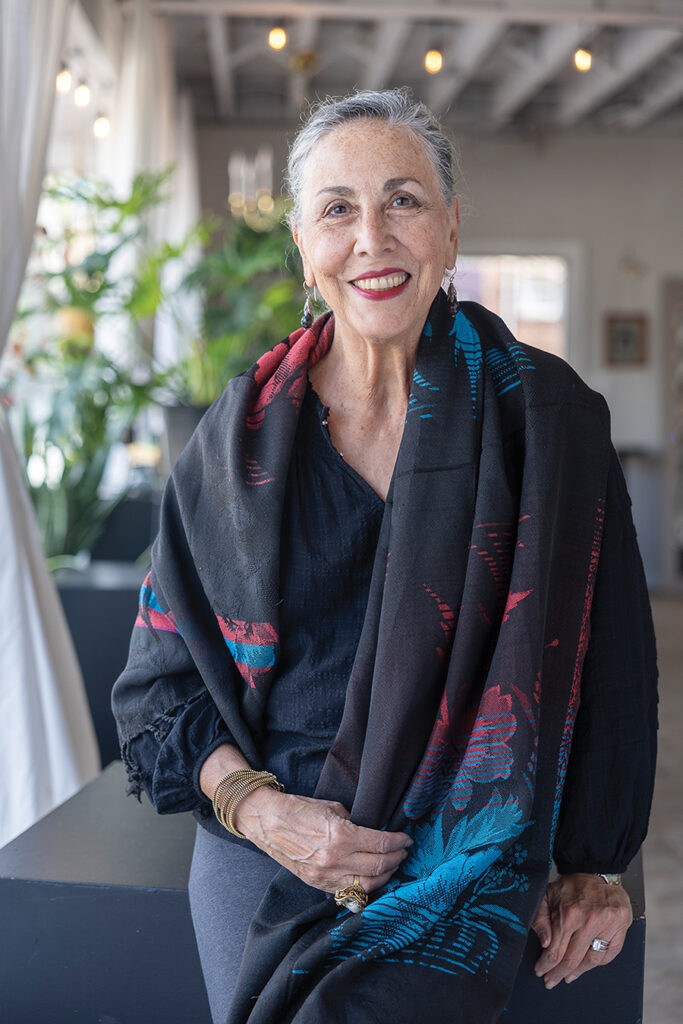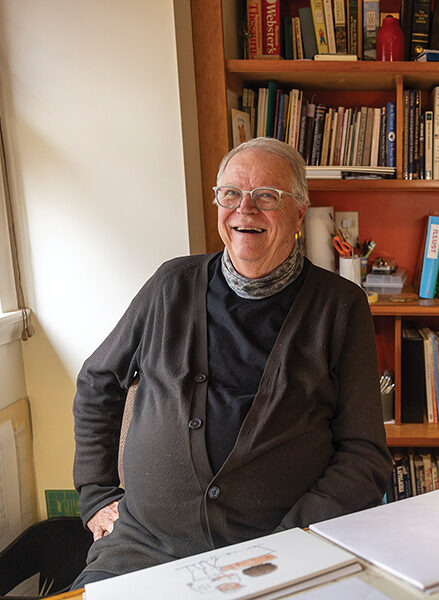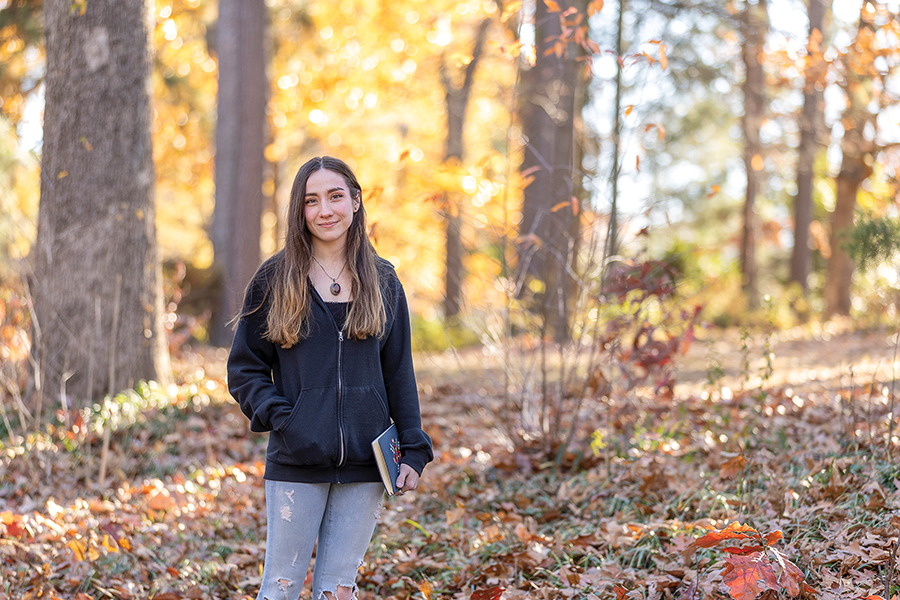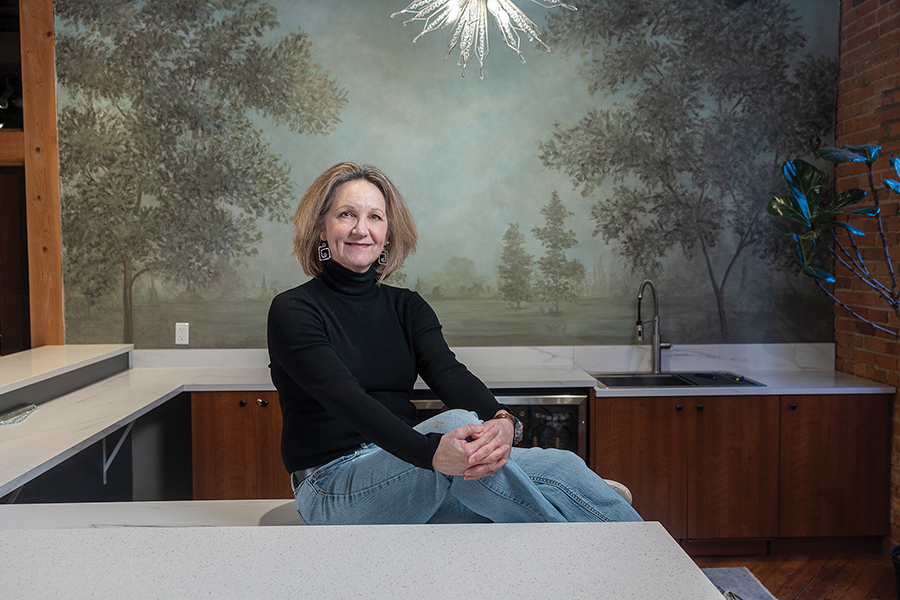Creatives on Creativity

How four locals work artfully
By Cynthia Adams
Photographs by Bert VanderVeen

Linda Lane, textiles and interior design
Linda Lane, who began her career as both a textile and interior designer, seeks inspiration in the greater world.
She is especially focused upon surface patterns, discovering “inspiration everywhere as I am out and about . . . manhole covers, plantings while walking my dog, a fallen branch or seed pods. Nature always inspires, never disappoints and teaches me about color palettes.”
Lane keeps a dedicated workspace, where she goes irregularly. But, she says, “Lately I am taking a different approach and dedicating daily time to ‘work’ on whatever I wish. That can include a lesson on YouTube, a seminar on Zoom or cataloging my hundreds of photos for inspiration and to use them further in developing an idea.”
Her workspace may appear chaotic to others — “but not to me! I like visible stacks or piles spread out around me to move from one idea or medium to another: sewing, printing, drawing, mood boards and music help me sustain a productive period.”
Once committed to an idea, Lane uses various methods “to see how it holds together,” such as reviewing former concepts with fresh eyes.
“Sometimes I revisit my sketchbook after years have passed.” Lane mentions how her mother nurtured her art, saving childhood artwork. They remind her that the young artist “is still inside of me and needs help to rise to the surface and to not be constricted by perfectionism.”
When a work in textile or home design is completed, she periodically asks if it has met the test of time.
“Time is the best teacher. If it holds up after months or years then it doesn’t have a ‘sell by’ date on it.”

Harry Blair, illustrator
As a child, Harry Blair drew and doodled in school. A science teacher noticed and, rather than punishing him, hung his sketches up in the classroom.
He believes the truest answer to where creativity comes from, and how, is unknowable. Children, he suggests, seem to innately possess it — unless, of course, it is squelched.
“It’s always seemed to me children, 5–6 years old, are the perfect example of creativity, having not been taught what is the wrong way or right way of doing something,” says Blair. “That is what I strive for — that freshness, the magical quality of drawing something never seen before. Kids are ruined by first grade because they look at the kid next door to see what they drew.”
He thinks he escaped that ruinous fate, thanks to his own innate sense of knowing what is true and that creativity is doing something new.
How do his drawings emerge? “I visualize things that I think are flying around in the air . . . That’s where the magic comes in . . . I watch a drawing being drawn without consciously drawing it.”
Once an idea enters Blair’s head, he’ll do a quick sketch that brings into focus what he sees with his mind’s eye.
Sometimes he evaluates a sketch and throws it away. “Other times it takes a 24-hour look-see. At that point I generally know if it’s good or not.”
He works at an antique table that is the center of his creative universe, a table that he believes is a century old.
“It came from Grimsley High back when they had drafting classes. Heavy. Beautiful. You don’t see them anymore.”
Fifty years ago, when they were cleared out, he asked to buy one. “And they said, ‘Take one!’ I was teaching art at the time at Page.”
He keeps reminders of past work while at work positioned on the same desk near a window. There’s a (figurative) camel displayed from when he did agency work promoting Camel cigarettes. “I have to be comfortable and well lighted.”
What does he credit as the source of his creativity? Blair’s unsure. “I saw Keith Richards recently — maybe on Jimmy Kimmel, and he asked how Keith did a riff . . . Keith said, ‘I don’t know.’”
Blair chuckles. “That’s a true answer.”
“There are days when I struggle, when it doesn’t flow like a river. I have to put it down and do something else.” He adds that such days are few.
Yet he’s grown kinder and gentler with himself. He’s less self-critical. And he doesn’t hold himself to a routine.
Although he taught art early in his career, Blair firmly thinks creativity is ineffable.
“I don’t think you can teach creativity . . . I don’t think you can teach someone who’s a pretty good artist to be a better artist.” Creativity, he explains, arises; “it happens or not.”

Brianna Campbell, singer
Brianna Campbell recalls how her grandmother, “a really charitable person,” encouraged her to sing. Beyond that, she taught her granddaughter how to sign for the deaf so that she could sing in sign language. “I look up to my whole family,” says Campbell gratefully. “They give me the purpose to create.”
Now she writes her own lyrics, often singing while on the job at Friedrich Metal Products building industrial smokehouses and chillers. It’s a job that sees her frequently traveling to installations across the country. (Campbell is currently studying laser welding.)
While a student at Greensboro’s Weaver Academy, she attempted sculpture welding for the first time. Competing against 2,600 students at the 2017 SkillsUSA Leadership and Skills State Conference, she won first place. Campbell subsequently earned a full scholarship to Tulsa Welding School in Jacksonville, Florida, where she was among few female students.
Before SkillsUSA, she’d never tried welding sculpture, but possibilities were opened. “I went to nationals after that. And all roads lead to Rome. Your creativity, your will and devotion can get you further than anything in life.”
As she sees it, “creativity is everywhere.”
Campbell explains creativity is “problem-solving,” much as Jobs believed.
“It’s seeing what everyone else has seen,” she says. “But thinking what no one else has thought.”
Artistic ideas occur to Campbell most often while traveling, walking in the woods or enjoying music. “It’s very chaotic to most people, but I just feel like when you are an artist, the inspiration is visible to you at random times and you never know when it will be.”
While she seeks inspiration from her surroundings, she usually writes her songs in silence. But that’s not to say it’s a silent process: “I am alone a lot, but you can almost always see me singing to myself,” says Campbell. “It’s always a new song I’m working on. Occasionally, when writing music, I will change the lighting to write the song because light affects your mood and so does your environment.”
Campbell figures out the instrumentation for the song and whether she wants harmonies. When lyrics later come to mind, Campbell uses any surface available — even her wrist.
“Everywhere, people and their stories inspire me . . . music is a shared experience because it’s usually relatable to the listener in some way and it’s powerful enough to be part of our identity.”
Campbell will soon complete a yet to be titled album in early 2024, electing to find a local artist to produce the album cover.

Dana Holliday, mural artist
Thomasville artist Dana Holliday is just off a patchy international call with her mother, Sue Canoy, who is in Nepal “on a yoga and walking trek.” (Canoy, like her daughter, also draws and paints. Both seek global inspiration for their work.)
Within Holliday’s extensive portfolio are specialized trompe l’oeil installations and murals for a variety of showrooms at the International Home Furnishing markets.
She finishes what she starts. Holliday once completed a massive commission for Currey & Company at High Point Furniture Market with one arm in a cast after falling from a scaffold. “I was painting a lady getting shot out of a cannon.” She jokes dryly, “How ironic.”
Holliday often works on three different projects at once. She believes creativity “is being able to paint a mural or painting from scratch without a clue of what it will become.”
She is inspired by both internal and external ideas, “usually drawn to nature, trees and other organic objects. And then, dreams. Even bad dreams.”
Typically painting in her studio (“It’s organized chaos!”) on a fixed schedule from 11 a.m.–5 p.m., she finds a routine solidifying. The artist frequently shows her personal work, including encaustic paintings using wax. Holliday often seeks out experts in techniques, absorbing the ways others have perfected their practices, “wanting to make it my own.”
Her artistic family offers commentary.
“Last year, my brother, Cary, reeled me in and said, ‘You’re getting fancy. You’re not speaking to light and shape.’ And he was right.”
Challenging herself to create a new, minimalistic group of paintings, she stripped away inessentials. “That was really difficult for me, but I decided to do it and I did it.”
Influenced by Impressionism and the works of Georgia O’Keeffe, her travels have caused her to seek out artists in Europe, South America and New Zealand. Holliday, who also works in abstracts and portraiture, recently studied artist Ezshwan Winding’s encaustic and abstract painting techniques at her studio in Miguel San Allende, Mexico.
In 2023, she studied in western Ireland with Lora Murphy and Alicia Tormey. Tormey, an encaustic artist, pioneered the form. Murphy creates both oil and cold wax portraits.
She repeatedly checks finished work, asking, “Is this what I started out to do?”
Holliday asks, “Why did I choose to be an artist?”
Was the artistic life a choice at all, she wondered, or a compulsion?
Scientific American’s “Messy Minds of Creative People,” defined certain traits— plasticity, emergence, divergence — concluding that creativity “was messy.”
Rick Rubin decided the creative life wasn’t messy at all. Mysterious yet intentional. “Art is choosing to do something skillfully, caring about the details, bringing all of yourself to make the finest work you can. It is beyond ego, vanity, self-glorification and need for approval.”
